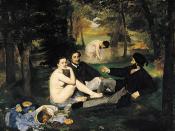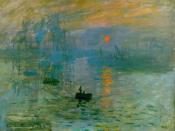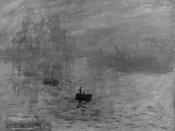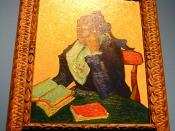The visual art of the Modern era from 1870 to 1914 can be gauged by a sheer number of such movements and styles as Impressionism, Post-Impressionism, Fauvism, and Expressionism. Edouard Manet's Luncheon on the Grass, Claude Monet'sImpression: Sunrise, and Vincent van Gogh's The Night Café are three typical masterpieces that express sharply their defiance of the norm in order to lay out new techniques and ideas.
Edouard Manet was a French painter whose work inspired by the impressionist style, but who refused to so label his own work. His influence on French painting and the general development of modern art was due to his portrayal of everyday subject matter, his use of broad simple color areas, and his vivid, summary brush technique (Edouard). In Luncheon on the Grass, Manet depicted the subject of the painting that was directed against by the public outcry: "a female nude among two fully clothed young men and another clothed female figure" (Lawrence, 490).
To be more precise, in the foreground, three characters are seated on the grass: a naked woman and two men dressed like dandies. The woman, whose body is starkly lit, looks frankly in the direction of the viewer. The man on the right is wearing a flat hat with a tassel. The men seem to be engaged in conversation and totally ignore the woman. In front of them, the clothes of the woman, a basket of fruit and a round loaf of bread are displayed as in a still life.
In the background, there is another woman, draped in an almost transparent cloth, bathing in a small pond. She is too large in comparison with the figures in the foreground and seems to float. The backdrop is painted roughly and lacks depth: one gets the impression that the scene doesn't take place outside, but in a photographer's studio. This impression is reinforced by the use of broad light, which casts almost no shadows. In fact, the lighting of the scene is inconsistent and unnatural. One can also note that the sort of hat the man is wearing was normally only for indoor use. According to Lawrence in Culture and Values A Survey of the Humanities, it is not difficult to perceive the "particular air of reality in Manet's scene" and his interest in "showing us how he sees" rather than "telling us what his characters are doing" (490). In turn, anything not in viewers' center of vision, in reality is not in clear focus, and this was how Manet painted.
Manet was committed to Realist ideas in his painting of Luncheon on the Grass. He and other realists believed that the common man, the real people were important individuals and worthy of representation. His subjects in Luncheon on the Grass were actual people of his time, people that he knew, that he could actually see. And Manet lifted the veil of illusion and bluntly confronted the public with reality.
Impression: Sunrise is the most famous painting of Claude Monet, an Impressionist painter during the late nineteenth and early twentieth centuries, for which the Impressionist movement was named. The title of the painting, Impression: Sunrise implies that the painting is only an impression of what any real sunrise could be, expressing the idea that only the real thing could be as satisfying. But by giving an impression, it reaches towards providing an implied substitute. Moreover, Claude Monet'sImpression: Sunrise epitomizes impressionistic artwork with its defining style of fluttery brush strokes and a blurry portrayal of an actual image (Henry 499). The quick, indistinct brush strokes, and the incredible use of light, brings the sunrise to life, time and time again. The light pinks used in the upper background profess the rising sun, while the ship's sails dominate the lower background. The blur of the ships and the sharp, defined area of the sun reflect the opposing significance of each object. The smaller boat in the foreground is one of the only blackened areas in the painting, signifying its importance in the painting.
In general, Monet wants to capture an exact moment of this particular sunrise. The idea was to paint the sunrise, the way the light reflected upon the water, and he quickly captured this moment as it is impressed in his own mind. Monet doesn't care if viewers recognize a boat or a person and he wants the viewers to see the beauty of the reflection. The goal is to recreate the visual experience of the effect of light and movement on objects, and in this instance, on water and the surrounding natural setting at this precise moment. Monet did exactly that in Impression: Sunrise.
The Night Café that was described by van Gogh as "one of the ugliest I have done" was painted during the period of Post-Impressionism, which was more of a time period than an actual style (Lawrence, 500). It depicts the interior of the cafe, with a half-curtained doorway in the center background leading, presumably, to more private quarters. Five customers sit at tables along the walls to the left and right, and a waiter in a light coat, to one side of a pool table near the center of the room, stands facing the viewer. Precisely, yellow walls give on to blood-red walls that lead to an obtrusive green ceiling, and lining the walls are the locals at the bar tables, hunched over in late-night stupor. Lamps hang from the ceiling, surrounded by Vincent's wheels of curving yellow strokes. As van Gogh wrote: "I have tried to express the terrible passions of humanity by means of red and green", his attention is to show the lowest edge of humanity, without adornment, with as much impact and sincerity as possible (Analysis).
In The Night Café, van Gogh not only paints with his own style, but definitely his own ideas. Just as his style is different at different times in his life, his ideas also change. Surely, each of his paintings has its own meaning, in other words, van Gogh's own meaning, and often the meaning is left to individual interpretation. However, in this particular piece we are lucky enough to have a record of some of van Gogh's thoughts contained in a letter written to his brother. The painting was meant to convey an oppressive atmosphere. He wrote to his brother that this was "a place where one can ruin oneself, go mad, or commit a crime..." (Analysis). These were his own thoughts and feelings at the time he painted this piece and he wanted to convey them to his viewer.
In summary, the artists of previous periods who were commissioned and made fairly good money had the clergy and the nobility take care of them. They were considered craftsmen, and they painted for their commissioners. Conversely, Manet, van Gogh, and Monet painted for themselves. Their paintings are means to express their new techniques and ideas as Manet in his subject matter, van Gogh in his illustration of feeling and meaning, and Monet in his new impressionistic technique.
Works CitedAnalysis of The Night Café - Vincent van Gogh, Article City, October 11 2006, July 27, 2009. Edouard Manet, Renoir Fine Art, July 27, 2009.
< http://www.renoirinc.com/biography/artists/manet.htm>Henry M. Sayre, A World of Art, 5th edition, Pearson Education, 2004.
Lawrence Cunningham and John Reich, Culture and Values A Survey of the Humanities, Thomson Wadsworth, 2002.





